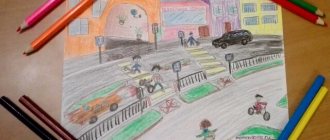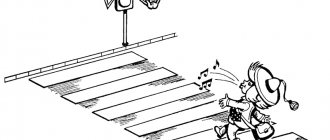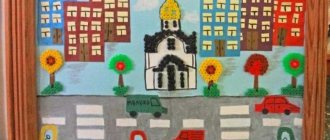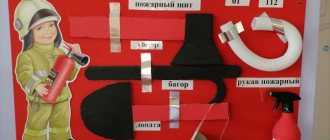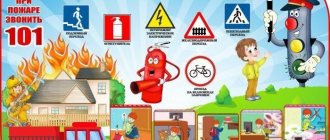Conversation with parents “Child and the Road” consultation (junior group)
Conversation with parents
"The Child and the Road"
Parents should pay great attention to children's compliance with the rules of behavior on the street. When crossing the street with a child, adults must hold his hand. Otherwise, the child may become frightened by the approaching car and suddenly run across the road, putting himself in danger. It is necessary to explain to children that they cannot go out alone, without adults, onto the roadway, but when crossing the street with a child, teach him the correct reaction to traffic lights, to walk calmly, without rushing. At the request of the teacher, parents can clarify with their children the names of the streets along which they go to kindergarten, the purpose of the road signs they encounter, and remember the rules for driving on the sidewalk and crossing the road.
On the street, adults should not remain indifferent to the behavior of children who go out for a walk unaccompanied by their elders. In order to instill independence in children when moving along the street, it is good to give instructions in a playful way, but with a specific purpose that is understandable to the child. For example: “You take me to the bakery today, and we will buy bread with you,” the mother says to the child. - “But before you go, tell me which side of the sidewalk we need to walk on, where we will cross the road,” etc. The child acts under the control and accompaniment of an adult. Completing such tasks sets a specific goal for the child, consolidates knowledge of the rules of movement on the street, develops observation, the need to think, imagine, mentally divide the path into small segments, determine the location of landmarks and designate them with words.
Dear moms and dads!
The best way to save your life and the life of your child on the roads is to follow the traffic rules! Educating children in safe behavior skills on city streets is a very important problem. The question may arise: why explain to children the peculiarities of traffic, the rules of crossing the street, if kids still cross the road only holding the hand of an adult? Perhaps we shouldn’t bother them with these rules while they still don’t walk the streets on their own or use public transport? But we must always remember that the formation of conscious behavior is a long process. Today the child walks everywhere hand in hand with his mother, and tomorrow he will become an independent pedestrian and passenger of city transport.
Work on teaching children the rules of competent and safe behavior on city streets and in public transport must be systematic. For it to bring results, one lesson or conversation with children is not enough. And one more important requirement: children do not have enough theoretical knowledge, they must apply it in practice.
In kindergarten we hold conversations, classes, games, entertainment, and exhibitions on this topic. But this is not enough - the practical application of this knowledge falls entirely on your shoulders. The unity of our and your requirements for children is a condition for the safety of our children! Children are always next to us, they look at us, imitate us. They are our life, our continuation, our meaning to preserve our future - our children, to ensure their health and life - the main task of parents and all adults. Dashingly, pressing on the gas at the wheel of your cars, crossing the roadway at a red traffic light or generally in the wrong place, do not forget that next to you are your children, the same road users, repeating and completely copying the disdainful and often dangerous attitude of adults towards compliance with traffic rules. It is adults (parents) who create negative habits of violating the rules of safe behavior on the road - the basis for a possible future tragedy. Parents must firmly grasp the power of their own example.
You are an object of love and imitation for a child. This must always be remembered, and even more so when you take a step onto the roadway with your baby.
The main reasons for children breaking rules are:
- Failure to observe;
- Personal indiscipline of children;
- Inattention and carelessness.
We offer you a selection of materials on two main
areas of work:
- Formation of special skills in children;
- Teaching children the rules of safe behavior while walking.
Recommendations for developing special skills in children.
1. The skill of switching to the street. When approaching the end of the sidewalk, to the curb, stop, slow down, take a pause necessary for psychological switching in connection with the transition to a dangerous zone (roadway), look around the street in both directions.
2. The skill of calm, fairly confident behavior on the street. When leaving home with your child, do not be late, leave early so that you have some time to spare when walking calmly.
3. The skill of switching to self-control. The ability to monitor one’s behavior is developed through daily training under the guidance of parents.
4. The skill of anticipating danger. Conduct lessons on anticipating hidden dangers while on the sidewalk, in the area of a pedestrian crossing or public transport stop.
Repeatedly show your child from the sidewalk:
- a standing bus (in front) and a passing car suddenly driving out from behind it;
- a standing bus (from behind) and an oncoming car suddenly driving out from behind it;
- a standing truck or car and another vehicle suddenly driving out from behind it;
- bushes, trees, fences, piles of earth and snow, construction materials near the road and vehicles leaving behind them;
- moving vehicles and a car overtaking the first one and leaving behind it;
- moving traffic and an oncoming car driving out from behind it.
It is necessary to ensure that the very sight of objects that interfere with a free view of the streets is perceived by the child as a signal of danger, as a recommendation for increased caution. The conditioned reflex “danger of an obstacle blocking the view of the street” should be developed.
Draw children's attention to the deceptiveness and danger of deserted streets with little traffic. They are no less dangerous than busy streets: without seeing vehicles or hearing their noise for several minutes, children often go out and even run out onto the roadway without examining it, intuitively assuming that “the street is empty.”
5. Observation skill. Approaching the roadway, the child should turn his head “left-right” and look around the street in both directions. This should be brought to automaticity. The child should inspect the road several times, as the situation on the road can change dramatically. Before you take your first step off the sidewalk, you should look “to the left.” Having reached the middle of the roadway, you need to look “to the right”.
The child should look especially carefully at the street when his home, acquaintances, and relatives are on the opposite side, when the child crosses the street after other children or adults. In these cases, it is easy to miss the moving vehicle.
Teach your child to peer into the distance and quickly notice a car, motorcycle, scooter, bicycle, because sometimes a child looks, but does not notice a car or motorcycle driving in the distance.
As you watch for approaching vehicles, keep track of the time it takes for the vehicle to pass you with your child. Having learned to count “seconds”, the child will learn to correctly determine the speed of a vehicle and anticipate the moment of its approach.
Teach your child to determine the direction of future traffic: which car will go straight and which one is preparing to turn (the turn signal is on).
Parents of those children who have significant deviations from the norm in vision, and in particular use glasses, must take into account that in this case the observation and orientation of the child on the street is sharply complicated. “Lateral vision,” which plays an important role in noticing vehicles approaching from the side, is much weaker in children with visual impairments than in children with normal vision.
Such a child must be even more attentive, since he may make a mistake in determining the distance to the vehicle and its speed, and may not notice the car. It is advisable for a child wearing glasses to compensate for the lack of vision by turning his head more frequently and carefully and looking at the street “left” and “right.”
Recommendations for teaching children safety rules while walking.
1. When leaving home:
- if vehicle traffic is possible at the entrance of the house, immediately draw the child’s attention and together look to see if a car, motorcycle, moped, or bicycle is approaching you;
- If there are vehicles at the entrance or trees growing that block your view, stop your movement and look around to see if there is a hidden danger behind the obstacle.
2. When driving on the sidewalk:
- do not lead the child along the edge of the sidewalk: the adult must be on the side of the roadway;
- a small child should walk next to an adult, holding the hand tightly; parents should be prepared to hold him when he tries to escape;
- teach your child, when walking along the sidewalk, to carefully watch the exit from the yard or from the territory of the enterprise;
- show and explain to children that throwing stones at the roadway (with stones, glass, etc.) and damaging road signs can lead to an accident;
- do not teach children to go out onto the roadway: carry strollers and sleds with children only on the sidewalk;
- When a group of children moves, teach them to walk in pairs, without leaving the column, without disturbing its order, and following all the instructions of the adults accompanying the children.
3. When preparing to cross the road:
- stop, slow down, look at the roadway;
- involve your child in monitoring the situation on the road;
- emphasize your movements: turning your head to look around the street, stopping to look at the road; stop for passing cars;
- teach your child to peer into the distance and distinguish between approaching vehicles;
- do not stand with your child on the edge of the sidewalk, as when passing the vehicle can get caught, knocked down, or run over with its rear wheels;
- draw the child’s attention to the vehicle preparing to turn, talk about the direction indicator signals of the car and the gestures of the motorcyclist and cyclist;
- Show your child repeatedly how a vehicle stops at a crossing, how it moves by inertia, how the driver tries to stop it abruptly so as not to hit a pedestrian.
4. When crossing the roadway:
- cross the road only at pedestrian crossings or at intersections - along the sidewalk line, otherwise the child will get used to crossing where he has to;
- Go only when the traffic light is green. The child must get used to the fact that they do not turn to red or even yellow signals, even if there is no transport. Do not cross the road at a red traffic light: if a child does this with you, he will do it even more so alone;
- when going out onto the roadway, stop talking; the child must get used to the fact that when crossing the road, talking is unnecessary;
- do not rush and do not run; always cross the road at a measured pace, otherwise the child will learn to rush and run where he needs to be observed to ensure the safety of the crossing;
- do not cross the road at an angle to the axis, emphasize and show the child every time that you are walking strictly across the street. The child needs to be explained that this is being done for better monitoring of vehicles;
- do not go out onto the roadway with your child from behind a vehicle or from behind bushes without first inspecting the street, as he will learn to do the same - this is a typical mistake of children;
- do not rush to cross the road if on the other side you see: friends, relatives, acquaintances, the right bus or trolleybus. Don’t rush and don’t run towards them, teach your child that this is dangerous;
- Don't start crossing a street where traffic rarely passes without looking around. Explain to your child that cars can unexpectedly leave the alley or the yard of the house;
- When crossing a roadway at an unregulated crossing in a group of people, teach your child to carefully monitor the start of traffic, otherwise the child may get used to imitating the behavior of his companions when crossing, without watching the movement of traffic.
5. When boarding and disembarking from public transport vehicles (bus, trolleybus, tram and taxi):
- go out first, ahead of the child. Otherwise, a small child may fall, an older child may run out from behind a parked vehicle onto the roadway;
- if you and your child are the last to leave, then warn the driver not to close the doors, thinking that boarding and disembarking are completed;
- Approach the vehicle door only after it has come to a complete stop. A child, like an adult, can trip and get run over;
- do not board public transport (trolleybus, bus) at the last moment when it departs (you may get pinched by the doors). The front door is especially dangerous, as if pinched by it, you can get under the wheels of this vehicle;
- Teach your child to be careful in the stopping area - this is a dangerous place for a child: a standing bus reduces the view of the road in this area, in addition, pedestrians here are often in a hurry and can push the child onto the roadway.
6. When waiting for public vehicles:
- bus, trolleybus, taxi: stand with children only on landing platforms, and if there are none, on the sidewalk or side of the road;
- taxi: if you need to stop the car outside the landing area, stand with your child only on the sidewalk or side of the road;
- tram: you should stand on a special landing area to wait for rail transport on the roadway, and if there is no landing area (on narrow sections of the roadway) - only on the sidewalk or side of the road; After disembarking from the tram with your child, do not linger on the roadway.
Recommendations are given for teaching children the rules of safe movement in a vehicle. When driving in a car:
- teach preschool children to sit in the car only in the back seat; do not allow them to sit next to the driver unless the front seat is equipped with a special child seat. Explain to them that during a sudden stop or collision, the force of inertia suddenly throws the child forward and hits the glass or front panel. This is enough for him to die or be seriously injured;
- Do not allow a small child to stand in the back seat while driving: in the event of a collision or sudden stop, he may fly over the back of the seat and hit the front window or panel;
- the child must be accustomed to the fact that the father (mother) gets out of the car first to help the child get off and bring him to the crossing or intersection;
- Do not allow children to be in the vehicle unattended.
- the child must know that it is allowed to carry only one child under seven years of age on a bicycle, and only on condition that the bicycle is equipped with an additional seat and footrests.
When traveling in a public vehicle:
- teach children to hold firmly to the handrails so that when braking the child does not get injured from an impact;
- Teach your child that you can only get on and off any type of transport when it is stationary.
A child learns the laws of the road, first of all, from the example of adults. The example of elders should help the child develop the habit of behaving in accordance with the Traffic Rules. This is the main factor in developing disciplined behavior on the street. In other words, the success of preventing child road injuries depends on the consciousness, personal culture and discipline of the parents themselves. Do not remain indifferent to the behavior of strangers, not your children, on the road. Perhaps a remark you made to your child, a helping hand extended in time, will prevent a possible disaster.

